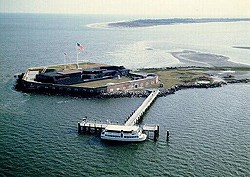
NPS Events moved rapidly this month, with a dizzying quickness that kept residents of the nation in suspense. On the 3rd President Lincoln met with his Cabinet to discuss the Fort Sumter situation. Lincoln repeated his desire to resupply the fort, an act that would not intimidate the Confederates, but did not appear weak either. The decision to resupply the post was sent to its commander, Major Robert Anderson, as well as the South Carolina government. Lincoln wanted to be clear that this was an act of resupply, not reinforcement. The Charleston Mercury reported that South Carolina would see this as an act of war. Growing impatient with the standoff, on the 11th, the Confederate Secretary of War instructed General P.G.T. Beauregard, commanding at Charleston, to demand the fort's surrender. When Anderson refused, the Confederates began to bombard the fort at 4:30 a.m. on the 12th. The bombardment lasted through the day and into the next. Major Anderson surrendered at 2:30 p.m. on the 13th, and turned the fort over on the 14th. There were no casualties during the shelling. Ironically, Major Anderson had been General Beauregard's artillery instructor at West Point. Upon hearing the news, Lincoln acted quickly. On the 15th he issued a call for 75,000 volunteers to suppress the rebellion in the southern states. This touched off anger in the upper south states that had not seceded: North Carolina, Tennessee, Arkansas, and Virginia. Lincoln's actions were seen by many as a betrayal- using force to coerce the southern states. Two days later, Virginia voted to secede, 88 to 55. The matter was put to public referendum on the 23rd, but no one doubted the outcome. Men rushed to fill the ranks on both sides of the Potomac. Troops from across the north descended on Washington to defend the capital, while from across Virginia, men moved swiftly to training camps around Richmond. On the 19th, an angry pro-secession mob attacked the 6th Massachusetts Regiment as they marched through Baltimore. Secessionists had been gaining ground in Virginia over the past few months. While Unionism was strong in parts of the state, the Fort Sumter incident and Lincoln's call for troops pushed many into the secessionist fold. The April 17th headline of the Lynchburg Virginian read, "War! War! War!" On the 19th, Union naval forces abandoned the large base at Norfolk, burning supplies that they could not take away. That night, in his Arlington Mansion overlooking Washington D.C., Colonel Robert E. Lee of the 2nd U.S. Cavalry wrote his resignation letter from the U.S. Army. Monday, the 22nd, local militia units organizing in Lynchburg received orders to report to Richmond. The next day, the troops formed and marched to the railroad depot, where civilians gave them a farewell. On the same day the state government appointed Robert E. Lee as commander of Virginia's state forces. Also on the 23rd, Danville received a call for units to go to Richmond, and the Danville Blues, Captained by William P. Graves organized to leave. They became Company A of the 18th Virginia, and the Danville Grays, led by Captain Thomas D. Claiborne, formed Company B. As men enlisted in their neighborhoods and towns, they formed companies of 100 men, often with local names like the Liberty Guards or Appomattox Rangers. These companies then went to larger towns like Lynchburg or Richmond where they received training and obtained arms. Frequently, men from the same church, workplace, or social club enlisted together. Fathers, sons, brothers, and cousins also joined together. George Peers, Appomattox County Clerk, wrote that, "The enlistment was rapid and soon the tramp of soldier boys drilling and preparing for the fray, and the hep, hep, hep of the cadet drill-master, were familiar sights and sounds on the streets and old fields at and about the court house." The Nottoway Grays, another local unit, also received a telegram ordering them to Richmond. At the state capital, these units from across the state were gathered and organized into regiments, most with companies from the same city, county, or region. The Nottoway Grays became Company G of the 18th Virginia Regiment. Seven companies that formed in Lynchburg became the nucleus of the 11th Virginia Regiment (a regiment having ten companies). Students from Lynchburg College formed the Lynchburg Rifles, an example of one of the companies that joined the 11th Virginia. |
Last updated: March 31, 2012
